中西文化之鉴 Chapter10
- 格式:ppt
- 大小:10.53 MB
- 文档页数:88
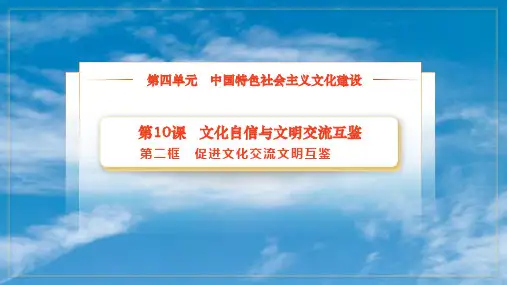

1、谈谈你对佛教精神的理解。
佛说法四十九年,留下许多的教理。
二千五百多年来,世界各地的高僧大德、殚精竭虑、苦研精究;莫不深深地佩服释迦牟尼的博学多闻,论理的精辟,思想的严密,以及救世的仁心。
随著科学的日新月异,这些佛理不但没有同科学相冲突,反而与科学一再地印证,证明它的永恒性与真实性。
佛教所以能历久常新,一直屹立不移,靠的不是威势强权,也不是愚民神话,而是一种道道地地、客观如实,且可以加以修行证得的伟大教理:一、佛是人而不是神遍看全世界各个宗教,除了佛教之外,没有一个宗教的教主不是以超人的‘神’格自居的。
这个神能够呼风唤雨,点石成金;他主宰著人类的吉凶祸福,它操纵著万物的生死荣辱。
人类只有匍匐在祂的面前,赞美与讴歌,把一切成就荣耀归于万能的神,信仰祂的才能上天堂,反对祂的只有堕入地狱,绝无抗辩申诉的余地。
而佛教的教主——释迦牟尼,他来到人间的第一句话就说:‘天上天下,唯我独尊。
’这里要请读者们注意的是:‘唯我独尊’的‘我’字,并不是单指的释迦牟尼本身,而是指的全体人类的每一个人。
二、佛教是真平等者佛教把平等的观念,不局限于万物之灵的人,佛教反对除人类以外的一切动物都是被创造来给人饱享口腹的论调。
佛教更进一步地肯定这些被我们自诩为万物之灵的人类所滥捕乱杀的动物,无不具有佛性——一种来日可以成佛的潜能,纵使人与其他动物之间,在形体上、智慧上有所不同,但在求生存的权利上,在佛性上却是平等的。
三、佛法是入世的佛教讲的道理,虽然最终的目的是‘出世’的,但它和‘入世’的精神并不抵触。
佛经上所讲的:‘佛法在世间,不离世间觉,离世求菩提,恰如觅兔角。
’就是说明修行要在人间,觉悟也要在人间,每一个有心向道的人,他不可能厌弃这个世界,逃避这世界上的人类,而‘独善其身’地修成正果。
因为一个人要想成佛,他除了具备聪明智慧之外,还要有广大的誓愿悲心去普渡众生。
2、中国古代阴阳五行的文化内涵。
阴阳五行,是阴阳学说和五行学说的合称。
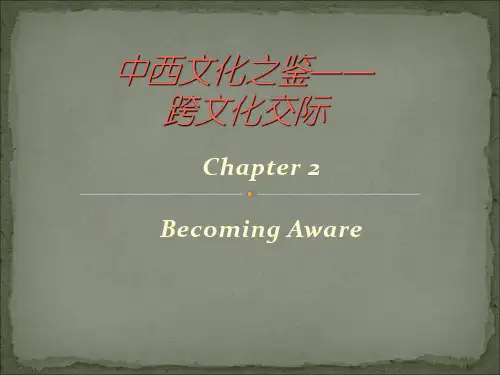
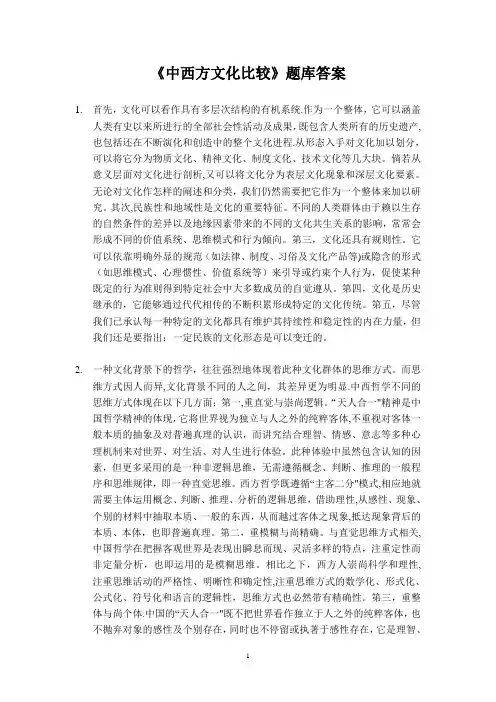
《中西方文化比较》题库答案1.首先,文化可以看作具有多层次结构的有机系统.作为一个整体,它可以涵盖人类有史以来所进行的全部社会性活动及成果,既包含人类所有的历史遗产,也包括还在不断演化和创造中的整个文化进程.从形态入手对文化加以划分,可以将它分为物质文化、精神文化、制度文化、技术文化等几大块。
倘若从意义层面对文化进行剖析,又可以将文化分为表层文化现象和深层文化要素。
无论对文化作怎样的阐述和分类,我们仍然需要把它作为一个整体来加以研究。
其次,民族性和地域性是文化的重要特征。
不同的人类群体由于赖以生存的自然条件的差异以及地缘因素带来的不同的文化共生关系的影响,常常会形成不同的价值系统、思维模式和行为倾向。
第三,文化还具有规则性。
它可以依靠明确外显的规范(如法律、制度、习俗及文化产品等)或隐含的形式(如思维模式、心理惯性、价值系统等)来引导或约束个人行为,促使某种既定的行为准则得到特定社会中大多数成员的自觉遵从。
第四,文化是历史继承的,它能够通过代代相传的不断积累形成特定的文化传统。
第五,尽管我们已承认每一种特定的文化都具有维护其持续性和稳定性的内在力量,但我们还是要指出:一定民族的文化形态是可以变迁的。
2.一种文化背景下的哲学,往往强烈地体现着此种文化群体的思维方式。
而思维方式因人而异,文化背景不同的人之间,其差异更为明显.中西哲学不同的思维方式体现在以下几方面:第一,重直觉与崇尚逻辑。
“天人合一"精神是中国哲学精神的体现,它将世界视为独立与人之外的纯粹客体,不重视对客体一般本质的抽象及对普遍真理的认识,而讲究结合理智、情感、意志等多种心理机制来对世界、对生活、对人生进行体验。
此种体验中虽然包含认知的因素,但更多采用的是一种非逻辑思维,无需遵循概念、判断、推理的一般程序和思维规律,即一种直觉思维。
西方哲学既遵循“主客二分"模式,相应地就需要主体运用概念、判断、推理、分析的逻辑思维,借助理性,从感性、现象、个别的材料中抽取本质、一般的东西,从而越过客体之现象,抵达现象背后的本质、本体,也即普遍真理。
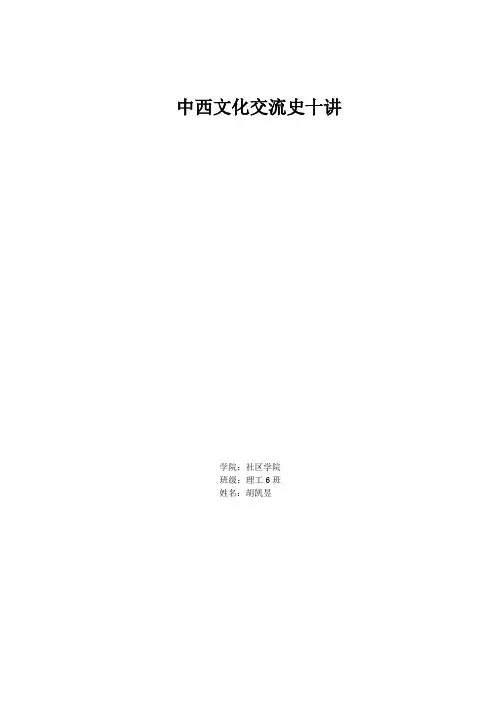
中西文化交流史十讲学院:社区学院班级:理工6班姓名:胡凯昱中国佛教的传入世界三大教派为佛教、基督教和伊斯兰教,但是对中国影响最大的还是本土三大教派佛教、道教和儒教。
它们曾对我国古代的思想文化和社会生活的许多方面都产生过深刻的影响,但现在在神州大地上广为传播的还是佛教,几乎处处都能看到它的踪迹。
中国有佛教四大名山:五台山、普陀山、峨眉山和九华山;四川有乐山大佛,河南登封有少林寺,洛阳有白马寺;等等这些无不说明佛教对中国文化具有深远影响。
佛教产生于距今三千多年由(今尼泊尔境内),虽然我们可能会潜意识的认为佛教是由印度传来,但事实并非如此,是迦毗罗卫国王子乔达摩·悉达多所创。
佛教也是世界三大宗教之一。
佛,意思是“觉者”。
佛又称如来、应供、正遍知、明行足、善逝、世间解、无上士、调御丈夫、天人师、世尊。
佛教重视人类心灵和道德的进步和觉悟。
佛教信徒修习佛教的目的即在于依照悉达多所悟到修行方法,发现生命和宇宙的真相,最终超越生死和苦、断尽一切烦恼,得到究竟解脱。
乔达摩·悉达多20岁时离家成道,此后被尊称“佛陀”,意为觉悟者,简称“佛”,所传宗教被称为“佛教”。
佛陀示现涅槃后的数百年间,佛教传遍印度次大陆。
原始佛教内部由于对教义的理解不同,发生分裂,进入部派佛教时期,主要分为上座部和大众部,南传佛教主要是上座部诸派,盛行于斯里兰卡,并传遍东南亚地区,后传入中国云南。
当然还有其他说法:秦始皇四年(西元前二四三)西域僧人室利房十八人齎持佛经来长安」、「汉武帝元狩二年(西元前一二一)霍去病讨匈奴时得金人,安置於甘泉宫」、「西汉哀帝元寿元年(西元前二),博士弟子景宪受大月氏王使伊存口授浮图经」等。
然在诸传说中,一般以「汉明感梦,初传其道」的说法最为有名,三国以来即被盛传。
汉明帝梦一金人於殿廷,以占所梦,傅毅以佛对。
帝遣郎中蔡愔、博士弟子秦景等往天竺。
愔等於彼遇见摩腾、竺法兰二梵僧,乃要还汉地,译《四十二章经》,二僧住处,今雒阳门白马寺也。
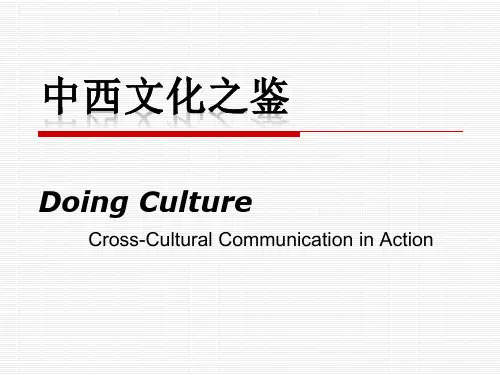
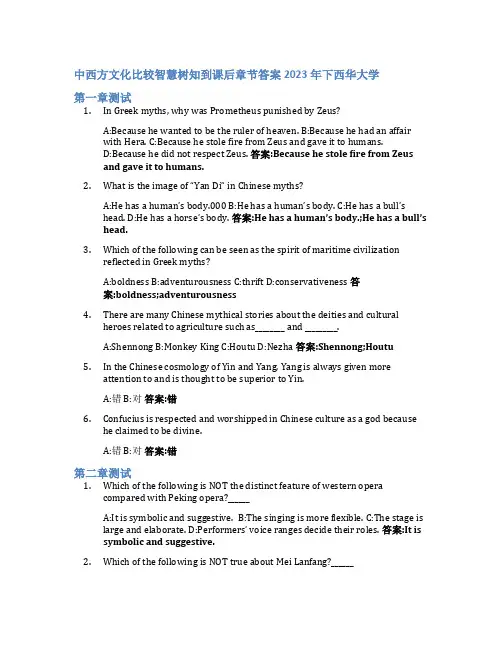
中西方文化比较智慧树知到课后章节答案2023年下西华大学第一章测试1.In Greek myths, why was Prometheus punished by Zeus?A:Because he wanted to be the ruler of heaven. B:Because he had an affairwith Hera. C:Because he stole fire from Zeus and gave it to humans.D:Because he did not respect Zeus. 答案:Because he stole fire from Zeusand gave it to humans.2.What is the image of “Yan Di” in Chinese myths?A:He has a human’s body.000 B:He has a human’s body. C:He has a bull’shead. D:He has a horse’s body. 答案:He has a h uman’s body.;He has a bull’s head.3.Which of the following can be seen as the spirit of maritime civilizationreflected in Greek myths?A:boldness B:adventurousness C:thrift D:conservativeness 答案:boldness;adventurousness4.There are many Chinese mythical stories about the deities and culturalheroes related to agriculture such as________ and _________.A:Shennong B:Monkey King C:Houtu D:Nezha 答案:Shennong;Houtu5.In the Chinese cosmology of Yin and Yang, Yang is always given moreattention to and is thought to be superior to Yin.A:错 B:对答案:错6.Confucius is respected and worshipped in Chinese culture as a god becausehe claimed to be divine.A:错 B:对答案:错第二章测试1.Which of the following is NOT the distinct feature of western operacompared with Peking opera?______A:It is symbolic and suggestive. B:The singing is more flexible. C:The stage is large and elaborate. D:Performers’ voice ranges decide their roles. 答案:It is symbolic and suggestive.2.Which of the following is NOT true about Mei Lanfang?______A:He composed many new melodies. B:He created various dances. C:He made innovations to the facial makeup, hairstyles and costumes. D:He wrote some plays for Peking opera. 答案:He wrote some plays for Peking opera.3.The features of Gothic architecture could be mirrored in Gothiccostume,including______.A:pointed sleeves B:pointed shoes C:stiff-bodiced dresses D:high headdresses 答案:pointed sleeves;pointed shoes;high headdresses4.Ancient Chinese architecture features timber framework has severaladvantages, including______.A:vulnerable to fire B:time-consuming C:windows and doors would not berestricted D:resistant to earthquakes 答案:windows and doors would notbe restricted;resistant to earthquakes5.Ancient Chinese buildings enjoy external appearance while westernbuildings attach importance to internal richness.A:错 B:对答案:错pared with traditional Chinese costumes, the rules on colors of westerncostumes are less strict and obvious.A:对 B:错答案:对第三章测试1.Chinesse poetry is good at using( ) to display imagery.A:implication B:blank space C:brush D:euphemism 答案:blank space2.Poetry is closely related to ( ).A:syntax B:diction C:stanza D:music 答案:music3.According to Aristotle, the function of tragedy can be concluded as ( ).A:ecstasy B:elevation C:repugnant D:catharsis 答案:catharsis4.Three main subjects in western fiction are about fantasy, ( )and( ).A:adventure B:death C:war D:love E:religion 答案:adventure;religion5.The Dream of Red Mansions is a typical history romance.A:错 B:对答案:错6.Chinese Peking opera usually uses symbolic performance on stage.A:对 B:错答案:对第四章测试1.What does "吃" mean in Chinese expression "吃不准"?A:to suffer B:to eat C:to understand D:to get 答案:to understand2.Which of the following statement is NOT true about eating in the west?A:Do not make slurping noises while sipping from a spoon. B:Always sip from the tip rather than the side of the spoon. C:Always sip from the side of thespoon rather than the tip. D:Do not make harsh noise by touching plates orcups with utensils. 答案:Always sip from the tip rather than the side ofthe spoon.3.Which of the following names does not belong to the praising type?A:燕窝福字什锦鸡丝 B:翡翠虾球 C:江山万代 D:龙凤呈祥答案:翡翠虾球4.Which of the following are the factors contributing to the development ofagricultural culture in China?A:human’s desire B:rich landforms C:oceanical environment D:favorableclimates E:continental movement 答案:rich landforms;favorable climates 5.There is no common point between Buddhism and Christianity.A:对 B:错答案:错6.As to fry, there are more kinds of subclassification in Chinese cooking than inthe western counterpart.A:对 B:错答案:对。

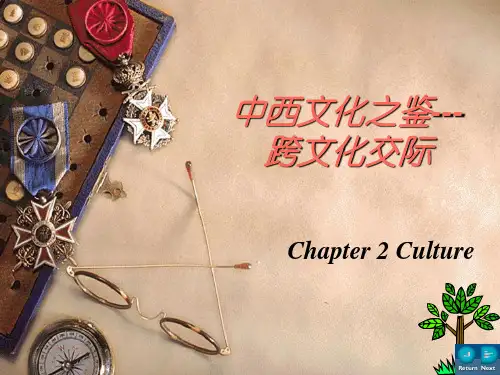
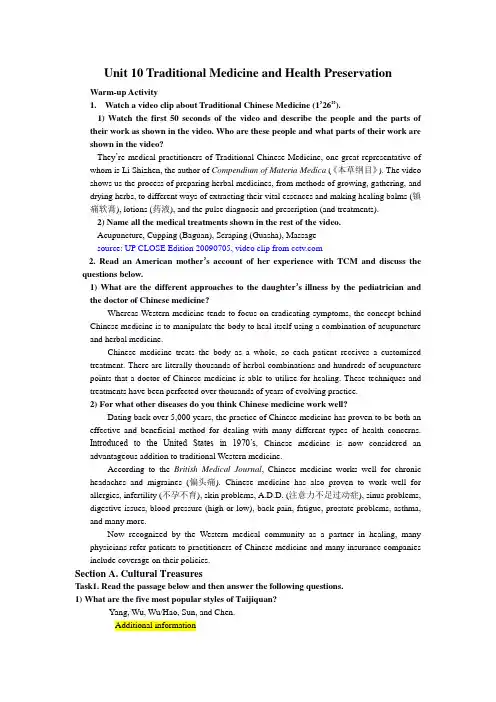
Unit 10 Traditional Medicine and Health PreservationWarm-up Activity1.Watch a video clip about Traditional Chinese Medicine (1’26”).1) Watch the first 50 seconds of the video and describe the people and the parts oftheir work as shown in the video. Who are these people and what parts of their work are shown in the video?They’re medical practitioners of Traditional Chinese Medicine, one great representative of whom is Li Shizhen, the author of Compendium of Materia Medica (《本草纲目》). The video shows us the process of preparing herbal medicines, from methods of growing, gathering, and drying herbs, to different ways of extracting their vital essences and making healing balms (镇痛软膏), lotions (药液), and the pulse diagnosis and prescription (and treatments).2) Name all the medical treatments shown in the rest of the video.Acupuncture, Cupping (Baguan), Scraping (Guasha), Massagesource: UP CLOSE Edition 20090705, video clip from 2. Read an American mother’s account of her experience with TCM and discuss the questions below.1) What are the different approaches to the daughter’s illness by the pediatrician andthe doctor of Chinese medicine?Whereas Western medicine tends to focus on eradicating symptoms, the concept behind Chinese medicine is to manipulate the body to heal itself using a combination of acupuncture and herbal medicine.Chinese medicine treats the body as a whole, so each patient receives a customized treatment. There are literally thousands of herbal combinations and hundreds of acupuncture points that a doctor of Chinese medicine is able to utilize for healing. These techniques and treatments have been perfected over thousands of years of evolving practice.2) For what other diseases do you think Chinese medicine work well?Dating back over 5,000 years, the practice of Chinese medicine has proven to be both an effective and beneficial method for dealing with many different types of health concerns.Introduced to the United States in 1970’s, Chinese medicine is now considered an advantageous addition to traditional Western medicine.According to the British Medical Journal, Chinese medicine works well for chronic headaches and migraines (偏头痛). Chinese medicine has also proven to work well for allergies, infertility (不孕不育), skin problems, A.D.D. (注意力不足过动症), sinus problems, digestive issues, blood pressure (high or low), back pain, fatigue, prostate problems, asthma, and many more.Now recognized by the Western medical community as a partner in healing, many physicians refer patients to practitioners of Chinese medicine and many insurance companies include coverage on their policies.Section A. Cultural TreasuresTask1. Read the passage below and then answer the following questions.1) What are the five most popular styles of Taijiquan?Yang, Wu, Wu/Hao, Sun, and Chen.Additional informationAt the turn of the nineteenth century, a young man named Yang Luchan went from his home of Yongnian, Hebei province, to Chen village as a servant. There he learned taijiquan, and later returned home, where he became known as “Yang the Invincible.”Several of his students include the three Wu brothers, two of whom were local magistrates and scholars, Wu Chengqing and Wu Ruqing, and one a superior martial artist, Wu Yuxiang. All loved martial arts, and unlike Yang, were literate. Wu Yuxiang was briefly a student of Yang, and then, because Yang held back teaching, he went back to Chen village and Zhaobao village for training with Chen Qingping.Yongnian was a breeding ground for great martial artists, and this was a turbulent time. The eldest Wu brother found a text in a salt shop, attributed to Wang Zongyue from the turn of the nineteenth century. It was entitled A Treatise on Taijiquan (《太极拳论》). Prior to that time, taijiquan was referred to as Changquan (long boxing), or the Thirteen Movements. Wu Yuxiang, his brothers, and a nephew, Li Yiyu (and later Yang Banhou), worked on this manuscript to produce what are now known as the Classics. This body of work, consisting of approximately forty texts, expounds the philosophical and practical methods that most taijiquan schools claim as basic, common, and uniting. It includes, among other discussions, commentaries on sparring, the eight gates and five steps, the thirteen postures, the taiji circle, and qi circulation.Yang later moved to Beijing, taking a post with the Qing government teaching martial arts. He simplified some of the Chen movements. His sons, especially Yang Banhou, continued his work, and later Yang Luchan’s grandsons (from his son Jianhou), Yang Shaohou and Yang Chengfu, became famous for their skills, and their additions to the art, too.Yang Chengfu made the form smooth, large, and broad, popularizing it for young and old. It is his style of performance that is most popular today internationally. His style is most often referred to as Yang Style, although there are still scattered pockets of people performing sequences that are attributed to earlier members of the Yang family.Back in Yongnian, Wu Yuxiang created what is now known as Wu (or Hao) style from his studies with Yang, his training with Chen, and his study of the classics. This style is compact, simple, small in frame, and quite upright. Li Yiyu taught Hao Weizhen (1849–1920). In the capital, Wu Quanyou, a Manchu by birth and a student of Yang Banhou, created an elegant, medium-framed style referred to as Wu (different character and tone from Wu/Hao). It was passed on through Wu Jianquan (1870–1942) and is also quite popular.Hao taught the famous Sun Lutang (1861–1932). Already a well- known martial artist at the turn of the century, the latter created a new style of taijiquan, Sun, incorporating xingyiquan (形意拳) and baguazhang (八卦掌), which, like taijiquan, are considered internal arts based on similar principles. The Sun is a very distinctive style, still being taught by his daughter, Sun Jianyun, and gaining popularity.In 1928, Yang Chengfu traveled to Nanjing, Shanghai, Hangzhou, Guangzhou, and Hankou and taught taiji. This trip, plus the many people taught by the Yang Family in Beijing who migrated to other parts of the country, helped to popularize taijiquan throughout China. It was also in 1928 that Chen stylist Chen Fake (1887–1957) moved to Beijing and began teaching.By far the five most popular styles of taijiquan are Yang, Wu, Wu/Hao, Sun, and Chen.2)Why do so many people practice Taijiquan?Some devoted practitioners value taiji as a metaphor upon which to model Daoist attributes as a base philosophy to attain control over their lives. Some seek out taiji as a means of restoring lost health or controlling chronic illness. For many, it is just playful recreation or a way of socializing. Finally, for others, it may serve any combination of these functions.Task2. Read the passage again and then complete the following tasks.1)Translate the underlined parts into Chinese.①《易经》②易有太极,是生两仪,两仪生四象,四象生八卦③《道德经》④《黄庭经》⑤戚继光《拳经》Taijiquan was originally referred to as Changquan(long boxing), or the Thirteen Movements (十三势). The very term Taiji comes from the Zhou dynasty and an anonymous text, the Yijing (I Ching; the Book of Changes). Over three thousand years ago, the author wrote, “In all changes exists Taiji, which cause the two opposites in all things. The two opposites cause the four seasons, and the four seasons cause the e ight natural phenomena.”4)Explain the following terms and then put them into Chinese.1)neijia - Internal (“neijia”) styles are those which use fluid movements and dodges to avoid attacks. They are influenced greatly by Taoist teachings. Breathing techniques, balance and control are highly important with the internal styles. With internal styles, strength develops most in the torso and legs. The most well known of the internal styles is taijiquan which is practiced by millions of people all over the world. The graceful movements of taiji build muscular strength and are popular with old and young alike.Other internal styles include xingyiquan (形意拳) and baguazhang (八卦掌).内家拳2)yi lu - the long sequence that is the basis for traditional Yang, Wu, Hao, and Sun style sequences. 陈式太极拳第一路3)tui shou - push-hands, a type of sparring (对练) using light touch and redirection of force,developing greater efficiency and sensitivity. This type of sparring allows thedevelopment of important fighting skills without injury; it may also be applied toweapons, for example, “sticky”spear techniques (粘枪). 太极推手4)silk reeling- also called winding silk energy, refers to a set of neigong movementprinciples expressed in traditional styles of taijiquan, but especially emphasised by the Chen and Wu styles of taijiquan. The name derives from the metaphorical principle of "reeling the silk from a silk worm's cocoon". In order to draw out the silk successfully the action must be smooth and consistent without jerking or changing direction sharply. Too fast, the silk breaks, too slow, it sticks to itself and becomes tangled. Hence, the silk reeling movements are continuous, cyclic patterns performed at constant speed with the "light touch" of drawing silk. Silk reeling is trained in solo forms and stances as well as in pushing hands with a partner. 缠丝劲或缠丝功Section B. Cultural Knowledge CardingSkimming and scanning the following passage so as to finish Tasks 1 and 2.Task 1. Match the Chinese words or terms in the left column with their English equivalents in the right column.a.pharmacotherapy, acupuncture and moxibustion, massage 药疗、针灸、按摩b. dietary care and tonic medicines 食疗补药c. Warring States period 战国时期d. fangshi (gentlemen of remedies) 方士e. the arts of Zou Yan驺衍之术f. the Yin and Yang philosophies阴阳五行学说g. the Wuxing (five agents) 五行h. five flavours 五味five organs 五脏i. Yellow Emperor's Inner Canon 黄帝内经j. self-cultivation 养生k. twelve distinct jingmai 十二经脉l. nine types of needle 九针m. acupuncture points 针穴,穴位n. leaves of mugwort 艾叶o. a Western Han tomb at the Mawangdui site 马王堆西汉墓p. the chancellor of the Han Kingdom of Changsha西汉初期长沙国丞相r. Treatise on Cold Damage伤寒杂病论s. the Divine Farmer's Canon of Materia Medica 神农本草经t. Materia Medica, Systematised Monographs 本草纲目Task 2. Put the following words or expressions in Tables 1 & 2, and show them to your partner:①b ②f ③i ④h ⑤j⑥d ⑦g ⑧c ⑨c ⑩aRead the text more closely and finish Task 3 and 4.Task 3. Questions for thought and discussion based on the above passage.1)Match the traditional Chinese medicine classics and their authors.①Huangdi - Yellow Emperor's Inner Canon②Zhang Zhongjing - Treatise on Cold Damage③Tao Hongjing - the Divine Farmer's Canon of Materia Medica④Li Shizhen - Materia Medica, Systematised Monographs2) Briefly describe the excavated texts from a Western Han tomb at the Mawangduisite. How significant are they for the understanding of traditional Chinesemedicine?There were household manuals of remedies for various illnesses and early editions oftreatises found in the canons of acupuncture and moxibustion. They have not beentampered with by generations of editors keen to re-arrange and re-order according to theprejudices of their own time. Therefore they provide a window through which we areoffered a direct view of medical affairs in elite society of early imperial China.Task 4. What are the Chinese versions for the following sentences? Where are they taken from? What suggestions of health preservation do they give? Are they still practicalin today’s life?1)食不厌精,脍不厌细。
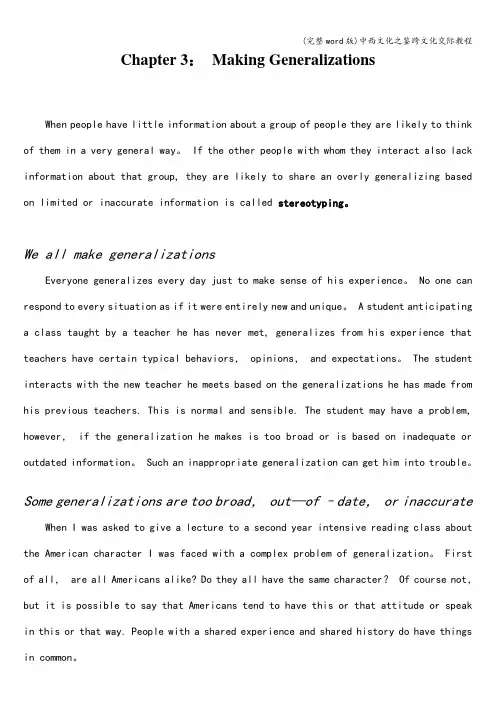
Chapter 3:Making GeneralizationsWhen people have little information about a group of people they are likely to think of them in a very general way。
If the other people with whom they interact also lack information about that group, they are likely to share an overly generalizing based on limited or inaccurate information is called stereotyping。
We all make generalizationsEveryone generalizes every day just to make sense of his experience。
No one can respond to every situation as if it were entirely new and unique。
A student anticipating a class taught by a teacher he has never met, generalizes from his experience that teachers have certain typical behaviors, opinions, and expectations。
The student interacts with the new teacher he meets based on the generalizations he has made from his previous teachers. This is normal and sensible. The student may have a problem, however, if the generalization he makes is too broad or is based on inadequate or outdated information。
中西文化之鉴课后习题答案中西文化之鉴课后习题答案在今天的课堂上,我们学习了中西文化之间的差异与相似之处。
为了加深对这一主题的理解,老师布置了一些习题。
现在,让我们来一起回顾并解答这些问题。
1. 中西文化的最大差异是什么?为什么会出现这种差异?中西文化的最大差异在于价值观和思维方式上的不同。
这种差异源于历史、地理、宗教和社会制度等多种因素的影响。
在西方文化中,个人自由、独立和竞争是重要的价值观,而在中国文化中,家庭、集体和社会和谐更为重要。
这种差异导致了在人际关系、权力结构和社会规范等方面的不同表现。
2. 中西文化的相似之处有哪些?这些相似之处对两种文化的交流和融合有何影响?中西文化在某些方面也存在相似之处。
比如,尊重他人、关注社会公义、追求知识和智慧等价值观在两种文化中都有共通之处。
这些相似之处为两种文化之间的交流和融合提供了基础。
通过相互学习和借鉴,中西文化可以相互补充,促进文化的多元发展。
3. 你认为中西文化的交流和融合对个人的成长和发展有何影响?中西文化的交流和融合对个人的成长和发展具有积极的影响。
通过学习和理解不同文化的优点和特点,个人可以拓宽自己的视野,开阔思维,增强跨文化交流的能力。
同时,不同文化之间的交流也可以促进个人的创新和创造力,激发潜能,提高适应多元文化环境的能力。
4. 你认为如何促进中西文化的交流和融合?为了促进中西文化的交流和融合,我们可以采取以下措施:首先,加强教育和宣传。
通过学校教育和社会媒体等渠道,向人们普及中西文化的基本知识和理念,增强文化交流的意识和兴趣。
其次,鼓励跨文化交流和合作。
通过组织文化交流活动、举办国际学术研讨会等方式,促进中西文化的交流和合作,增进相互理解和友谊。
最后,培养人才和专业人士。
通过设立中西文化交流专业、提供奖学金和交流项目等方式,培养更多的跨文化交流人才,推动中西文化的深入交流和融合。
5. 中西文化的交流和融合对于世界的发展和进步有何意义?中西文化的交流和融合对于世界的发展和进步具有重要意义。
Context in communication(09翻译2班黄子英 07号)AbstractContext is important in all communication,but it is relatively more important in some situations than in others.There are also some significant differences across cultures in the ways and the context to which people communicate through context.A high context(CH) communication or message is one in which most o f the informationis either in the physical context or internalization in the person, while very little is in the code,explicit,transmitted part of the information.Any transaction can be characterized as high , low or middle context.HC transaction feature preprogrammed information that is in the receiver and in the setting. With only minimal information in the transmitted message.LC transactions are the reverse. Most of the information must be in the transmitted message in order to make up what is missing in the context.Although on culture exists exclusively at one end of the scale, some are high while others are low. American culture , while not on the bottom,is toward the lower end of the scale.Key words : higher context,low context Time-Orientation, Humor ,AdaptationHigh context culture and the contrasting "low context culture" are terms presented by the anthropologist Edward T. Hall in his 1976 book Beyond Culture. It refers to a culture's tendency to use high context messages over low context messages in routine communication. This choice of communication styles translates into a culture that will cater to in-groups, an in-group being a group that has similar experiences and expectations, from which inferences are drawn. In a high context culture, many things are left unsaid, letting the culture explain. Words and word choice become very important in higher context communication, since a few words can communicate a complex message very effectively to an in-group (but less effectively outside that group), while in a lower context culture, the communicator needs to be much more explicit and the value of a single word is less important.General speaking, high context communication is economical, fast and efficient.It works as long as people communicating are looking for and understand the meaning in the context. It takes a long time to learn.It brings people together. Low-contextcommunication is more impersonal,but it is an effective way of transmitting information among people we do not share the same experience.It pays little attention to messages sent to non-verbally, they think communication is the exchange of verbal messages.They think that the speakers and writers are responsible for the success of communication. They should make meaning clear and understandable with their words.Context as a relativistic metric of culture cultural context does not rank as "high" or "low" in an absolute sense because each message can be presented on a continuum from high to low. Likewise, a culture (French Canadian) may be of a higher context than one (English Canadian) but lower context than another (Spanish or French). Likewise, a stereotypical individual from Texas (a higher context culture) may communicate more with a few words or use of a prolonged silence, than a stereotypical New Yorker who is being very explicit, although both being part of a culture which is lower-context overall.Higher context cultures tend to correlate with cultures that also have a strong sense of tradition and history, and change little over time. For example, the Native Americans is a higher context culture with a strong sense of tradition and history. The focus on tradition creates opportunities for higher context messages between individuals of each new generation. This is in contrast to lower context cultures in which the shared experiences upon which communication is built can change drastically from one generation to the next, creating communication gaps between parents and children, as in the United States.High-context joke from a high context culture will not translate well to someone of a different culture, even another high-context culture. Humor is very contextual, as a joke may not be considered very funny if it seems like it is over-explained using only low-context messages.Adaptation an individual moving to a higher or lower context culture may need to adapt and/or be accommodated in ways different than moving within cultures of similar context.High to Low: An individual from a higher context culture may need to adapt and/or be accommodated when shifting to a low context culture. A lower context culture demands more independence, and expects many relationships, but fewer intimate ones.A high context individual is more likely to ask questions rather than attempt to work out a solution independently, and the questions are likely to be asked from the same few people. The high context person may be frustrated by people appearing to not want to develop a relationship or continue to help them on an ongoing basis. The term 'Hand-holding' might be used in an unintentional derogatory sense.Low to High: An individual from a low context culture needs to adapt and/or be accommodated when shifting to a higher context culture. Higher context culturesexpect small close-knit groups, and reliance on that group. Groups can actually be relied upon to support each other, and it may be difficult to get support outside of your group. Professional and personal lives often intertwine. A lower context individual may be more likely to try to work things out on their own and feel there is a lack of self-service support or information, rather than ask questions and take time to develop the relationships needed to accomplish the things that need to be done.After the knowledge of the high and low context , we will have a relation of the proper communication codes. It will not only contribute to the grasp of information and the communication between and it will definitely boost the international relationship development.。
1. From what you know of the cultural grammar of the United States or another English speaking country, give advice to a Chinese English speaker about how to make a speech to a Western or International audience. (p24)The speaker should invent a new and attractive metaphor to carry their meaning. An image from their home culture might be fresher to her audience than their borrowed phrase.In Chinese culture a writer or speaker shows her learning by quoting famous people from the past. It is not necessary to even say where the quote comes from. The audience will know and will respect your knowledge. In the US people rarely quote famous people from the past unless it is an especially sentimental or patriotic occasion where it is understand that old and familiar images should be remembered. many people attend such events with an attitude of amused nostalgia(乡愁、怀旧之情).It might be fun to hear those old chiches again.(P23)2. Discuss the ways that hos ts in high-context cultures can meet the needs of low-context culture visitors for low-context information. (p61)Westerners appreciate the personal help they receive when they come to China, but they also want low-context information to help them plan, act and adjust to a new situation. High-context communicators need the low-context messages they receive, but without human helpers they experience their new cultural situation as cold and impersonal. Westerners want low-context information to help them plan, act and adjust to a new situation. They are more likely to assume that certain predictable services will be available such as hotel booking counters and transportation services and that they can find these and use them without any assistance.3. Discuss the ways that hos ts in low-context cultures can meet the needs of high-context culture visitors for high-context information. (p61)Westerners, as low-context communicators, look for, trust and use impersonal sources of information while communicators form more high-context cultures prefer personal sources of information. High-context communicators need the low-context messages they receive, but without human helpers they experience their new cultural situation as cold and impersonal. The hosts need to help them ready to various matters, so that they can quickly adapt to the new situation.4. Imagine that you are advising someone from China who is going on a extended trip to a low-context country. Explain to the person what changes he will need to make in his communication behavior in order to successfully communicate in a low-context culture. Then advise someone from a low-context culture on how he should change his communication beha vior inorder to communicate successfullyin China. (P65)Low-context communicatorsthink that the speakers and writersof words are responsible for thesuccess of communication. Theyshould make meanings clear andunderstandable with their words.Listeners and readers aresupposed to ask for clarification orfurther information if the words donot fully or clearly explain themeaning. In more informalsituations speakers willspecifically encourage listeners tointerrupt to ask questions.Low-context listeners andspeakers have similarexpectations in informalconversation. The speakerattempts to be clear and thelistener shows that he understandswith brief comments and facialexpressions. The speakersinterpret this as positive behavior.If the listener is silent it means thathe or she understands and acceptsthe message.High-context communicatorsexpect listeners to take moreresponsibility for interpreting themeaning of messages. Theyassume that speakers do notalways express their meaning fullyor precisely in words. It is up tothe listener to interpret themeaning of words by payingattention to the context in whichthey are said. From the point ofview of a low-contextcommunicator this sometimescauses high-contextcommunicators to find too littlemeaning in words and too muchmeaning in the situation.Differences in the significanceand reliability of messages sentthrough language and throughcontext are factors in almost allcross-cultural misunderstandingsbetween people from high-contextcultures and low-context cultures.The way people communicate ispart of their basic culturalsoftware, and it takes considerableeffort to modify this culturalprogramming to adjust tocommunicating situations that areculturally different. The first stepsare to understand thesedifferences and then to look forthem in every cross-culturalcommunication situation. By doingthis, high-context communicatorscan learn to use and respond towords differently and low-contextcommunicators can learn to payattention to context and learn tointerpret meaning in terms of thecontext.5. What is culture? How wouldyou explain the relationshipbetween language and culture?Culture is the total way of lifethat a group of people shares;Culture is a system of sharedbeliefs, values, customs, behaviors,and artifacts that the members of asociety use to cope with theirworld and with one another, andthat are transmitted fromgeneration to generation throughlearning.The close relationship betweenlanguage and culture is mostreadily seen in words. Words thatare intuitively recognizable arebasic units of nguage isa part of culture and plays a veryimportant role in it. Withoutlanguage, culture would not bepossible. On the other hand,language is influenced and shapedby culture, it reflects culture.Language is the carrier andcontainer of culture; it is themirror of culture. Language andculture is closely related, eachinfluencing and shaping each other.A language can never be learned ina culture vacuum.6. How do you understandindividualism in English culture?People from individualistcultures are more likely to act onprinciples that apply to everyone,principles that are universal andapply to associates and strangersalike. Individualists are more likelyto treat people they do not know asif they can be trusted, as if they,too, will behave according to thesame universal principles.Individualists are generallyconcerned about the processes ofdecision-making. Any behaviorthat attempts to seek an advantagefor one person over another basedon a personal relationship is seenas unfair or even as corrupt. Oftenindividualists strongly disapproveof attempts to gain preference, andthe person who does this may beseen as dishonest or unprincipled.7. How do you understandcollectivism in Chinese culture?Collectivism in Chineseculture means person belonging tothe society, personal interestsshould obey group, nationality,class and the interests of the state,it is a kind of spirit. The higheststandard of Collectivism is ourspeech and actions are accord withpeople's collective interests; thisis the communist world outlookand the important content of theproletariat. The scientific meaningis that while individual interestsand collective interests in conflict,we should subordinate to theinterests of the collective.8. What do you think of theadvantages ofindividualism-oriented values andcollectivism-oriented valuesrespectively?Individualism-oriented valuespay attention to individual value,freedom, and people withindividualism-oriented values maybe more innovative. Each person isseparate from others; he mayspeak his own mind and tell thetruth.Collectivism-oriented valueshave many advantages, such as thecooperate spirit .when makedecisions, the collectivists tend togive a higher priority torelationship than individualists do,they expect people who areinvolved in a group relationship tohave duties and obligations to oneanother. Duties include being loyaland furthering the interests ofgroup. So Collectivism-orientedvalues can let us makecontributions to group.9. What cross-cultural contrastscan you find between English andChines e responses tocompliments?In the west, people can e asy to accept compliments, because people are confident and frank. Chinese people are influenced by Confucian education for a long time, and formed the modest attitude. When people praise and praise, be modest or self-denial, otherwise, he or she may be treated as pride. The Chinese people pay attention to modest in communication, with the "humble yourself and people", to look at it as a virtue, it is one kind of rich Chinese culture characteristics of polite phenomenon. In others praise us, we tend to self-dispraise a to table modesty and polite. Western countries have no such cultural habits, when they are praise, there will always be very happy to say that a "yes" means to accept. Due to the differences between Chinese and western culture, we think the west too confident, not modest; When westerners heard Chinese people such a negative for their praise or hear their own negative their achievements, even those themselves naught, will feel very surprised.10. What cross-cultural differences can you find between English and Chinese modes of thinking?Western culture as linear cutting stroke, clear analysis, pay attention to abstract re asoning, analytical thinking, logical thinking.Chinese culture is like a circle sealed, viewing was close, seeking intuitive insight, good long image thinking.The Advantages of Each Mode of ThinkingThe linear mode of thinking characterized by analytical reasoning and emphasis on clarity and precision is conducive to theoretical construction. The circular mode of thinking characterized by synthetic insight and stress on fuzziness and implicitness contributes to empirical revelation of truth.11. What similarities and differences and you find between “ red “ and “红”?Red: in Chinese culture:Red is the color which Chinese people worship. The red color is usually associated with celebrations and joyful occasions. For Chinese, it’s the symbol of luck, happiness, success and festival. When festival comes, we h ang red lanterns, adhibit red couplet; wear red clothes (especially at the wedding ceremony). In china, “双喜” is either written in red or written on a piece of red paper to symbolize an event of special joy, such as a wedding or opening a business. Red: in Western culture: On the contrary, red has a rather bad meaning in western culture. It associates with blood, fire and evil. It’s the symbol of atrocity(残暴) , danger, violence, and debauchery(放荡). There are many phrases concerning red, for instance, “a red revolution”, “red alert”, “a red adventure story”, “a red flag”, “red battle”, “red ruin”, “a red light district”, all of which have derogatory senses.12. What similarities anddifferences and you find between“ white“ and “白”?White: in Chinese Culture: Whitehas derogatory sense in Chineseculture while it has acommendatory one in the west. InChina, it’s the symbol of death,depression, failure and threat.From of old, people have to wearwhite clothes as well as black oneswhen their relatives pass away.They regarded the white tigers asdemons. The losers waved whiteflags to show their surrender in thewars. White representsfoolishness when it’s used in theterm “白痴”. “白面书生” refers tothe bookman who is lack ofexperiences.White: In Western Culture: Inwesterners’ eyes, white equals tochastity and naivete. Bride wearswhite full dress at the weddingceremony. White Christmas: refersto snow at Ch ristmas time.Whitehope:refers to “a talented personwho is thought likely to bringsuccess or victory”.In conclusion, color terms implydifferent meanings in differentcountries. The preferencestowards different colors can showa nation’s aesthetic perception tosome extent. With thedevelopment of interculturalcommunication, I believe peoplewill know the cultural connotationof color words better.13.What similarities anddifferences and you find between“ blue“ and “蓝”?Blue:Blue has scarce symbolicmeaning in Chinese culture.Itdenotes gloomy emotion in thewest.(in a blue mood情绪低沉feelblue不高兴a blue outlook悲观的人生观)It is also regarded as thetoken of nobleness and sternness.Blue is also associated with highsocial position or beingaristocratic. It’s also the badge ofbawdry and indelicacy.Blue movie:a movie which contains obscenematerial h as explicit reference orportrayal of sexual acts.14.What similarities anddifferences and you find between“ black” and “黑”?Black: The concerned meanings ofblack in both eastern and westernculture are nearly the same. Itsymbolizes ferocity, seriousness,horror, death and blackness. InChinese, one use“黑心肠” todescribe someone who isvenomous. “黑幕” means frightfulsecret, inside story. In English,“black in the face” and “to lookblack at someone” are used to saypeople who are very angry. (西方文化中的“black” 既象征着死亡、罪恶和灾难,同时也象征着庄重,威严与尊贵。
Cross-cultural Communication●What is culture?1. a system of meaning1)Culture is like an iceberg (objective and subjective)2)Culture is our software (fade into the background, just know that we can be)3)Culture is like the water a fish swims in (a part of who we are and what the worldit like for us, taken for granted)4)Culture is the story we tell ourselves about ourselves (to show who we are andwhat the world is like)5)Culture is the grammar of our behavior (rules to behave appropriately)--Culture is the total accumulation of beliefs, customs, values, behaviors, institutions and communication patterns that are shared, learned and passed down through the generations in an identifiable group of people.--As participants, we are meaning makers--Cultures are always changing2. Four levels of cross-cultural awareness1)Cultural differences are exotic2)Cultural differences are frustrating3)The different culture is believable4)The different culture is believable as lived experience*P31*(a diagram!)●Stereotype1. Definition: A generalization that goes beyond the existing evidence, an inaccurate or over generalization, is a stereotype.2. Negative stereotypes--A generalization that goes beyond the existing evidence, an inaccurate or over generalization, is a stereotype. (positive vs. negative)--Prejudice: stereotypes including negative feelings and attitudes toward a group Forms:1)severe prejudice (e.g. Women are inferior to men.)2)symbolic prejudice (e.g. People from Xinjiang are thieves.)3)tokenism4)subtle prejudice5)real likes and dislikes6)preference for the familiar3. Differences:1)Stereotyping: A stereotype is an overly simplified/generalized way of thinkingabout a person, group, etc. Anyone can stereotype and can be the target of stereotyping. Stereotyping is a complex form of categorization that mentally organizes your experiences and guides your behavior toward a particular group of people.2)Prejudice: Prejudice refers to the irrational dislike, suspicion, or hatred of aparticular group, race, religion, or sexual orientation. Learned beliefs and values that lead an individual or group of individuals to be biased for or against members of particular groups are prior to actual experience of those groups. 3)Relations between them:Both are a stumbling block to ICC. Prejudice usually refers to the negative aspect when a group inherits or generates hostile views about a distinguishable group based on generalization. These generalizations are invariably derived from inaccurate or incomplete information about the other group. The generalizations are called stereotyping.Context1. Definition: The meanings that people exchange in ways other than language are usually referred to as context.2. Low context:1)tends to prefer direct verbal interaction2)tends to understand meanings at one level only3)is generally less proficient reading nonverbal cues4)values individualism5)relies more on logic; employs linear logic6)saying no directly7)communicates in highly structured messages8)provides details, stresses literal meanings9)gives authority to written information(Characteristics: impersonal, effective to transmit information, not necessary to have relationships)E.G. contracts between companies3. High context:1)tends to prefer indirect verbal interaction2)tends to understand meanings embedded at many socio-cultural levels3)is generally more proficient reading nonverbal cues4)values group membership5)relies more on context and feeling6)employs spiral logic7)talks around point8)avoids saying no9)communicates in simple, ambiguous, noncontexted messages10)understands visual messages readily(Characters: economical, fast and efficient, take long time to learn, bring people together)E.G. communication between close friends and family members*P58 Figure3*4. How people use wordsLC: pay little attention to messages sent non-verballyHC: have no difficulty understanding the meaning of contextual messages5. Responsibility for successful communicationLC communicators: the speakers and writers of words are responsible for the success of communicationHC communicators: expect listeners to take more responsibility for interpreting the meaning of messagesVerbal Communication vs. Non-verbal Communication1. Contextual frameworkExpectant behavior 期待行为Expectant norms 行为规范Expectant identity 身份2. Verbal CommunicationVerbal intercultural communication happens when people from different culturalcontextual framework3 expectations:Expectant behaviorExpectant behavior normsExpectant identitystructure and content of discourses1) quality principleThe language we use to express should be understandable to the listener. Fun, honest, harmonious (what is the general principle.)2) quantity principleThe amount of information needs to be concerned.Keep quiet3) relevance principleThe relevant information to both sides is differentMarriage, salary and weight.Direct --- indirect communication4) expression principleTranslationVietnam culture3. Non-verbal Communication1) It refers to communication through a whole variety of different types of signal come into play, including the way we act, the gestures we employ, the posture we adopt, the facial expression we wear, the direction of our gaze, to the extent to which we touch and the distance from each other.2) Functions:a)Repetitionb)Contradictionc)Substitutiond)Accentuatione)Complementf)Regulate3) Elements:a)Body languageb)Eye contactc)Facial expressionsd)Vocal cues— pitch, rate, volume, quality, articulatione)Space and timeStory1. Factors to form guiding functions of stories1)characters2)conflict3)action4)result•世界的运行方式(一般原则和特定语境)•我们的身份(个人身份和社会身份)•行为规范(有效性和恰当性)•判断尺度(好与坏、安全与危险)Individualism vs. Collectivism1. Individualism: pertains to societies in which the ties between individuals are loose. Everyone is expected to look after himself or herself and his or her immediate family.1) Manifestations:•personal privacy•personal freedom•personal equality•self-reliance•self-expression2) Advantages:•politics—democracy in America•economy—the thriving economy•culture—personal heroism•social life—personal desire comes first3) Disadvantages:•excessive disparities in wealthy•the existence of racial discrimination•other social problems2. Collectivism: pertains to societies in which people from birth onwards are integrated into strong cohesive in-groups, which throughout people’s lifetime continue to protect them in exchange for unquestioning loyalty.1) Manifestations:•group unity and harmony•group goals•hierarchy and interdependence•group-orientation•loyalty, conformity, humility2) Advantages:•community spirit—cooperate•economy—the thriving economy•culture—collective heroism•social life—one makes contributions to group3) Disadvantages:•not everyone has the team spirit•hierarch and personal inequality•leaders use public power for private•selfish in human nature•try to lazy and reduce payment as principle(*P232 Figure12!*)。